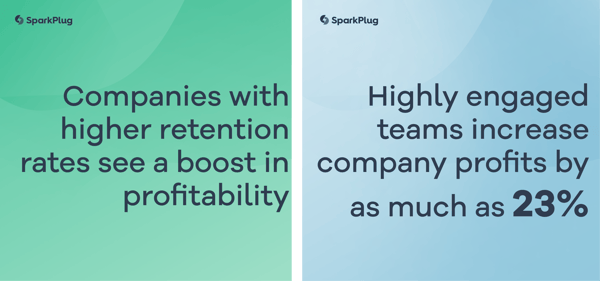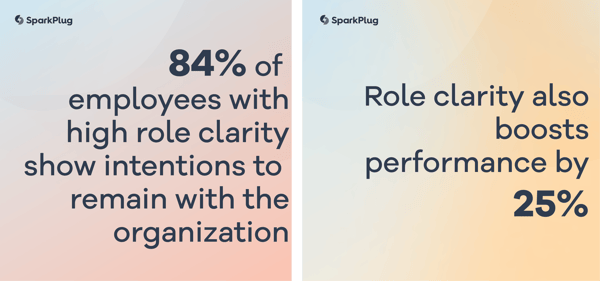Employee retention is crucial for businesses looking to grow and thrive in today's competitive landscape. It's not just about keeping people on the payroll – it's about nurturing a strong foundation from which a robust talent strategy can flourish, propelling your business to new heights. The importance of employee retention goes beyond simple continuity; it reflects an organization's commitment to its workforce and directly impacts its long-term success.
As companies navigate the complexities of modern markets, strategies focused on education, rewards, and training play pivotal roles in boosting employee retention. The art of keeping skilled staff members through thoughtful engagement and development initiatives is what separates the successful businesses from the fleeting ones. Let's dive into the steep costs of employee turnover and explore the benefits of maintaining a committed and content workforce, highlighting why it's imperative to prioritize employee retention.
Understanding Employee Retention
Grasping the nuances of employee retention is crucial for businesses aiming to foster a productive and stable workforce. Here's a breakdown of its core benefits and influences:
1. Productivity and Profitability:
- Retaining employees can significantly boost a company's productivity and profitability, as high employee turnover rates often go hand-in-hand with reduced operational efficiency.
- Companies that excel in employee engagement report a 21% increase in productivity and a 22% rise in profitability, underscoring the critical relationship between retention and financial success.
2. Employee Morale and Job Satisfaction:
- Employees who feel valued and appreciated are more inclined to stick around, leading to enhanced morale and job satisfaction.
- A stable and experienced workforce contributes to a positive work environment, allowing for the cultivation of valuable insights and expertise that drive improved business operations.
3. Cost Reduction and Customer Service:
- The advantages of maintaining a loyal employee base extend beyond morale, encompassing lower recruitment costs, heightened customer service quality, and the preservation of implicit knowledge crucial for seamless operations.
Notably, teams that have the opportunity to gel over time tend to exhibit higher productivity levels, further emphasizing the importance of employee retention in achieving operational excellence.

The High Cost of Employee Turnover
The costs associated with high employee turnover underscore the importance of effective employee retention strategies. Here's a breakdown of the financial implications:
Direct Costs:
Recruitment and Hiring: Businesses face substantial costs in advertising, interviewing, and hiring replacements, with the average cost of hiring a new full-time employee around $4,700.
Training and Onboarding: The cost of training a new hire averages $986 per learner, not to mention the administrative expenses involved in benefits enrollment and preparing training materials.
Salary and Benefits: Direct costs can amount to 33% of an employee's annual salary, factoring in the costs of hiring through recruiters which can be as high as 20-30% of a new hire's first-year salary.

Indirect Costs:
Depleted Morale: The departure of team members can lead to decreased workplace morale and overburden remaining employees, further affecting productivity and team dynamics.
Lost Knowledge and Revenue: Non-measurable costs such as reduced customer satisfaction, lost organizational knowledge, and deferred or lost revenue are critical considerations, often equaling or surpassing measurable costs.
Benefits of High Employee Retention
The benefits of high employee retention are multifaceted, impacting not only the internal workings of a company but its external reputation and performance as well. Here are some key advantages:
Cost Savings and Profitability:
Reduced Recruitment Expenses: High retention significantly decreases the need for frequent hiring processes, saving on advertising, interviewing, and training costs.
Increased Revenue: Companies with higher retention rates see a boost in profitability, with highly engaged teams increasing company profits by as much as 23%.
Enhanced Company Culture and Employee Morale:
Positive Work Environment: A stable workforce fosters a culture of respect, recognition, and opportunities for growth, making employees feel valued and engaged.
Experienced Team Dynamics: Long-tenured employees contribute to a positive company culture, mentor newer staff, and improve team efficiency.
Customer Satisfaction and Loyalty:
Knowledgeable Service: Experienced employees provide tailored customer service, building strong relationships that enhance customer satisfaction and loyalty.
Reputation as a Positive Workplace: High retention rates bolster a company's reputation, attracting top talent and giving it a competitive edge.
These elements collectively contribute to a robust, stable, and thriving business environment, underscoring the importance of prioritizing employee retention strategies.
Strategies for Improving Employee Retention
To enhance employee retention, businesses must adopt multifaceted strategies that address the diverse needs and preferences of their workforce. These strategies can be broadly categorized into three key areas:
Work Environment and Culture:
- Create a positive and inclusive work culture that fosters a sense of belonging and purpose among employees.
- Encourage teamwork and collaboration, reducing employee burnout by promoting a healthy work-life balance and offering wellness programs.
- Address management issues by adapting leadership styles to manage workload effectively, recognize employee contributions, and follow through on commitments.
Benefits, Compensation, and Incentives:
- Offer competitive salaries, regular salary evaluations, and comprehensive benefits packages, including health care and retirement plans.
- Implement flexible work arrangements, such as remote work options, reduced workdays, and flexible scheduling, to accommodate diverse employee needs.
- Incentivize loyalty and performance through utilizing incentive programs like SparkPlug.
Development and Career Opportunities:
- Provide opportunities for professional and personal development, including upskilling, tuition reimbursement, and mentorship programs.
- Align employee roles with their strengths and career aspirations, offering clear pathways for advancement within the organization.
- Foster a culture of continuous learning and improvement, ensuring employees feel valued and invested in their growth and success.
These strategies, when implemented thoughtfully, can significantly improve employee retention, contributing to a more engaged, motivated, and productive workforce.
The Role of Leadership in Employee Retention
Leadership plays a pivotal role in fostering an environment that encourages employee retention. Key areas where leadership impacts retention include:
Creating a Positive Culture and Role Clarity:
- Over half of American workers have left jobs due to poor leadership, underscoring the need for quality leadership that cultivates a positive culture and drives satisfaction.
- Role clarity significantly affects an employee's decision to stay, with 84% of employees with high role clarity showing intentions to remain with the organization. This clarity also boosts performance by 25%.
Trust and Psychological Safety:
- Trust, coupled with efficient communication, fosters psychological safety, crucial for retaining employees. Leaders should strive to connect emotionally, encouraging a healthy work-life balance.
- Transformational leadership positively influences organizational citizenship behavior, which in turn enhances retention. The relationship between transformational leadership and retention is further strengthened by effective communication.
Management Styles and Relationships:
- Micromanaging and absentee management styles can lead to decreased morale and increased turnover. Balanced leadership fosters ownership and engagement, improving morale and retention.
- Effective management, characterized by trust, communication, and understanding, is essential. Studies reveal 50% to 75% of employees leave due to their manager or factors the manager can influence.
Prioritizing employee retention strategies is not merely an HR task but a core business strategy that directly impacts a company's bottom line. By adopting these comprehensive approaches, businesses can navigate the complexities of modern markets more efficiently, ensuring both stability and growth.






